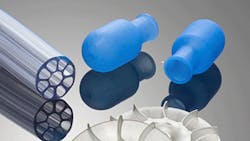Reinventing is Key to Manufacturing Growth Success
First a look back at Helix Medical’s roots in order to understand its future.
Going back 163 years, Carl Johann Freudenberg and his partner Heinrich Christian Heintze took over a tannery, thus forming the precursor to the Freudenberg Group (the parent company of Helix Medical.) Invention first struck in 1904 when the company developed a tanning process using chrome liquor instead of vegetable dyes, which reduced production time and propelled Freudenberg into one of the biggest tanneries in Europe.
Things progressed well until 1929 when reinvention was necessary again. The company reworked leather residues, developing substitute materials for leather that eventually led to synthetic leather and nonwovens, and soon were recognized as universally applicable materials.
From that point, the company expanded in different areas and set up factories around the world, until 2002 when they parted ways with its original line and closed the tannery. By this time the company was serving the automotive sector, which fell on hard times in the end of the 1990’s so change was necessary again.
Inward introspection led the company to focus on its core technologies and determine how they were applicable to other sectors. It was at this time the company decided to focus on the medical technologies market.
“The company was willing to cut its roots to be able to move toward the next new market,” explained Dr. Jorg Schneewind, President and CEO of Helix Medical.
Stragegic Expansion
The first step of entering the new medical market was the 2004 purchase of Jenline Industries Inc., a U.S. maker of liquid silicone rubber products for the medical-device and healthcare markets.
Next in 2006 Freudenberg-NOK, the U.S.-based joint venture of Freudenberg and Japan’s NOK Inc. purchased Helix Medical. Helix Medical provides custom manufacturing services for medical devices, components, and subassemblies. It also manufactures platinum-cured silicone tubing and fluid handling components for the pharmaceutical and biotech industries. The medical device division called InHealth Technologies develops and manufactures voice restoration products.
In 2008 the company added APEC. in 2008.”With the addition of APEC, we expanded our capabilities into the plastics segment and into production in China, which has become important as a lower-cost location as well as for serving our global customers locally in Asia,” explained Schneewind,.
All three of the U.S.-based companies have been integrated into one company — Carpinteria, Calif.-based Helix Medical LLC., which is currently 100% owned by the German-based Freudenberg Group, and supplies contract manufacturing services to medical device OEM’s worldwide.
“As our businesses grew organically, we acquired more companies to continue our growth,” commented Schneewind.
In 2010, Helix Medical purchased a 50% share of VistaMed Ltd., a company specialized in the development and manufacture of specialty catheter systems. Then in 2012 Helix added two more companies to the mix - in August Helix acquired a 50% share of Cambus Medical, a manufacturer of high precision hypotubes used in advanced catheter systems, and in October the company purchasedMedVenture Technology Corp., a medical device design, development, and manufacturing company.
All of these purchases are guided by key strategic selection criteria, Schneewind explains. “We examine the long term benefit of adding capabilities and providing service.” He adds that the company has a” long term perspective which is an important advantage when building for the future.”
Today Helix Medical has three manufacturing plants in Ireland, U.S. plants in Carpinteria and Baldwin Park, Calif., Jeffersonville, Ind.,and Gloucester, Mass., plants in Kaiserslautern, Germany, and Shenzen, China, as well as a $4 million plant in Alajuela, Costa Rica, which opened earlier this year.
“We continue to see growth in the medical device market. Demographics support this,”says Schneewind. “We also understand the challenges to be more cost-effective.”
However Schneewind isn’t worried. The bedrock of his company’s success is its ability to take its technology and adapt to the market. “With technology as our focus, we are well positioned to take advantage of this growth opportunity.”
